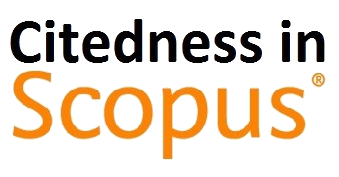Implementation of Data Mining Algorithms for Grouping Poverty Lines by District/City in North Sumatra
(1) Politeknik Bisnis Indonesia, Pematangsiantar, Indonesia
(2) STIKOM Tunas Bangsa, Pematangsiantar, Indonesia
(*) Corresponding Author
Abstract
The poverty line is useful as an economic tool that can be used to measure the poor and consider socio-economic reforms, such as welfare programs and unemployment insurance to reduce poverty. Therefore, this study aims to classify poverty lines according to regencies/cities in North Sumatra Province, so that it is known which districts/cities have high or low poverty lines. The grouping algorithm used is K-Means data mining. By using this algorithm, the data will be grouped into several parts, where the process of implementing K-Means data mining uses Rapid Miner. The data used is the poverty line data by district/city (rupiah/capita/month) in the province of North Sumatra in 2017-2019. Data sourced from the North Sumatra Central Statistics Agency. The grouping is divided into 3 clusters: high category poverty line, medium category poverty line, and the low category poverty line. The results for the high category consisted of 5 districts/cities, the medium category consisted of 18 districts/cities and the medium category consisted of 10 districts/cities. This can provide input and information for the North Sumatra government to further maximize efforts to overcome the poverty line in the area.
Full Text:
PDFReferences
D. V. Ferezagia, “Analisis Tingkat Kemiskinan di Indonesia Jurnal Sosial Humaniora Terapan,” Jurnal Sosial Humaniora Terapan, vol. 1, no. 1, pp. 1–6, 2018.
B. S. D. Bappeda DIY, “Laporan Akhir Analisis Kriteria Dan Indikator Kemiskinan Multidimensi Untuk Diagnostik Kemajuan Daerah Di Daerah Istimewa Yogyakarta,” Kerjasama Balai Statistik Daerah Bappeda DIY dengan Badan Pusat Statistik (BPS) Provinsi DIY 2017, pp. 1–97, 2017.
BPS, “II. Garis Kemiskinan (GK),” Badan Pusat Statistik Indonesia, 2020. [Online]. Available: https://www.bps.go.id/subject/23/kemiskinan-dan-ketimpangan.html. [Accessed: 01-Apr-2020].
A. Soleh, “Analisis dan Strategi Pengentasan Kemiskinan Di Provinsi Jambi,” Eksis: Jurnal Ilmiah Ekonomi dan Bisnis, vol. 9, no. 1, p. 79, 2018.
A. Firdaus, S. Martha, and N. Imro’ah, “Penentuan Garis Kemiskinan Provinsi Menggunakan Metode Multiple Classification Analysis,” Buletin Ilmiah Mat. Stat. dan Terapannya (Bimaster), vol. 08, no. 4, pp. 789–798, 2019.
Wikipedia, “Garis Kemiskinan,” 2020. [Online]. Available: https://id.wikipedia.org/wiki/Garis_kemiskinan. [Accessed: 01-Apr-2020].
I. S. Damanik, A. P. Windarto, A. Wanto, Poningsih, S. R. Andani, and W. Saputra, “Decision Tree Optimization in C4.5 Algorithm Using Genetic Algorithm,” Journal of Physics: Conference Series, vol. 1255, no. 1, pp. 1–6, Aug. 2019.
W. Katrina, H. J. Damanik, F. Parhusip, D. Hartama, A. P. Windarto, and A. Wanto, “C.45 Classification Rules Model for Determining Students Level of Understanding of the Subject,” Journal of Physics: Conference Series, vol. 1255, no. 1, pp. 1–7, 2019.
H. Siahaan, H. Mawengkang, S. Efendi, A. Wanto, and A. Perdana Windarto, “Application of Classification Method C4.5 on Selection of Exemplary Teachers,” Journal of Physics: Conference Series, vol. 1235, no. 1, pp. 1–7, Jun. 2019.
I. Parlina et al., “Naive Bayes Algorithm Analysis to Determine the Percentage Level of visitors the Most Dominant Zoo Visit by Age Category,” Journal of Physics: Conference Series, vol. 1255, no. 1, pp. 1–5, 2019.
D. Hartama, A. Perdana Windarto, and A. Wanto, “The Application of Data Mining in Determining Patterns of Interest of High School Graduates,” Journal of Physics: Conference Series, vol. 1339, no. 1, pp. 1–6, 2019.
Sudirman, A. P. Windarto, and A. Wanto, “Data mining tools | rapidminer: K-means method on clustering of rice crops by province as efforts to stabilize food crops in Indonesia,” IOP Conference Series: Materials Science and Engineering, vol. 420, no. 1, pp. 1–8, 2018.
B. Supriyadi, A. P. Windarto, T. Soemartono, and Mungad, “Classification of Natural Disaster Prone Areas in Indonesia using K-Means,” International Journal of Grid and Distributed Computing, vol. 11, no. 8, pp. 87–98, 2018.
A. S. Ahmar, D. Napitupulu, R. Rahim, R. Hidayat, Y. Sonatha, and M. Azmi, “Using K-Means Clustering to Cluster Provinces in Indonesia,” Journal of Physics: Conference Series, vol. 1028, no. 1, pp. 1–6, 2018.
BPS, “Garis Kemiskinan Menurut Kabupaten/Kota (rupiah/kapita/bulan), 2017-2019,” Badan Pusat Statistik Provinsi Sumatera Utara, 2020. [Online]. Available: https://sumut.bps.go.id/indicator/23/115/1/garis-kemiskinan-menurut-kabupaten-kota.html. [Accessed: 01-Apr-2020].
Z. S. Younus et al., “Content-based image retrieval using PSO and k-means clustering algorithm,” Arabian Journal of Geosciences, vol. 8, no. 8, pp. 6211–6224, 2015.
A. Wanto et al., Data Mining : Algoritma dan Implementasi. Yayasan Kita Menulis, 2020.
E. Prasetyo, Data Mining: Konsep dan Aplikasi menggunakan Matlab. Yogyakarta: Andi Offset, 2012.
D. T. Larose, Discovering Knowledge in Data: An Introduction to Data Mining: Second Edition. New Jersey: John Wiley & Sons, 2005.
R. Primartha, Belajar Machine Learning Teori dan Praktik. Bandung: Informatika Bandung, 2018.
T. Khotimah, “Pengelompokan Surat dalam Al Qur’an menggunakan Algortima K-Means,” Jurnal Simetris, vol. 5, no. 1, pp. 83–88, 2014.
I. Parlina, A. P. Windarto, A. Wanto, and M. R. Lubis, “Memanfaatkan Algoritma K-Means dalam Menentukan Pegawai yang Layak Mengikuti Asessment Center untuk Clustering Program SDP,” CESS (Journal of Computer Engineering System and Science), vol. 3, no. 1, pp. 87–93, 2018.
DOI: https://doi.org/10.30645/ijistech.v3i2.66
Refbacks
- There are currently no refbacks.
Jumlah Kunjungan:
Published Papers Indexed/Abstracted By:












